Characteristics of Forage Grass Artemisia sphaerocephala has strong anti-arid, drought-tolerant, cold-tolerant and thin-tolerant properties. It often mixes with flower buds, sand calluses, and sand rice, or forms a single dominant community. It grows on mobile and semi-mobile sand dunes. After the mobile sand dune was fixed. Seeds are highly viable. When buried in sand, the polysaccharides coated by the epidermis absorb water and form colloidal blisters. The amount of water absorbed can be equivalent to several times the seed weight, and the sprouting takes place very quickly. When the soil moisture content of sandy soil is less than 1%, the plants begin to wither. When the surface temperature of sand reaches above 60°C, they will not burn and die. In an arid environment with an annual rainfall of less than 100 mm, they can grow and develop normally. On the mobile sand dunes, the plant height can reach 150 cm, and the growth of the underground part is stronger than that of the aerial part. The root width of the 5th instar is 7.5 times that of the crown. Artemisia sphaerocephala grows slowly, generally returning to green in mid-March, and flowering on July 10th. Seeds mature in mid-September, and deciduous browns begin around November 10, with a fertility period of 120 days and a growth period of 180 days to 200 days.
Feeding value and utilization technology Feeding Artemisia sphaerocephala as a forage is mainly used for grazing in winter and spring, and its palatability is worse than that of other excellent pastures. In the green period of the growing season, only camel, sheep, and cows eat young leaves, after late autumn frost killing, palatability increased, most livestock feed, especially camel, sheep like to eat; sheep eat young leaves and seeds , Camel can eat young plants throughout the young period. The feed intake rate of 2nd-instar plants accounted for 2/3 of the whole plant, and for plants older than 3 years old, the feed intake rate decreased to 1/2~1/5. The plant height of natural life from 3 to 5 years is 50 cm to 100 cm, and the plant height after artificial planting for 3 to 5 years can be increased to 80 cm to 140 cm, and the total yield above ground is 1333 kg per mu. The growth of the year was 987 kg, and the weight of flowers and leaves was 613 kg, which accounted for about 62%, which could supplement the deficiency of pasture livestock in winter and spring.
Wind and sand fixation Artemisia halodendron grows in the desert and semi-desert areas for one year to form grass hedges, which plays a role in windbreak and sand fixation. According to the determination of desertification in Minqin, the wind speed at the height of 15 cm from the ground can be reduced by 54.7%, and the wind speed at the height of 30 cm is reduced by 16.5%, which is conducive to the fixation of quicksand and the formation of plant communities, thus protecting the grain fields. It is a pioneer species for windbreaks and sand fixation in mobile sand dunes.
After the fuel and other Artemisia sphaerocephala are fixed on the sand dune, when the natural vegetation coverage recovers to a certain degree, it will soon enter the ageing and death period. The diameter of the stem base of the hypertrophy can reach 5 cm to 7 cm, which is a good source of fuel for the people. Seeds have anti-heat, dewetting, cholestrol, diuresis and other disease-preventing effects, can be used as medicine, increase income. Seeds contain 21.5% fat and can also be eaten with oil. In food processing, the masses use their strong sticky seeds, often added to the flour after crushed, to increase the flour's strength and facilitate cooking. In the flour vermicelli production, adding a small amount of seed fine powder can improve the vermicelli and vermicelli flexibility. Easy to process and improve quality.
Cultivation techniques Soil cultivation and fertilization Land used for artificial direct seeding or nursery should be sand or loam, fine soil preparation before planting, deep plowing, post-winter irrigation, earthworms, leveling, repression and soil conservation before last year, combined with plowing before planting. Foot fertilizer, applied organic fertilizer per acre 1000 kg ~ 2000 kg. For afforestation wind and sand planting, should choose a smooth sand, strip preparation. When planting on sandy slopes, it is necessary to use a horizontal ditch, a water platform, a fish scale pit, a small hole, or a belt in the form of land preparation according to the topography. If sowing is used by airplanes, mild grounding, drawing, stepping and other ground treatment should be carried out after spreading so as to facilitate seed emergence and seedling emergence.
The cultivation methods for sowing Artemisia sphaerocephala include direct sowing, cutting and transplanting, and they can be selected according to needs and conditions.
Live seeds are dark brown, large in size, full, germinating, and pure seeds. The sowing period can be carried out in the spring when the soil thawing water content is relatively high to the two seasons before the end of July, and the unfavorable seedlings are overwintering late. Seeding methods can be used artificial sowing or aircraft sowing, can be unicast, but also with sand calluses, flower sticks, tops, sand rice and other grass seed mixed sowing, broadcast after the suppression of security, unicasting amount of 1 kg per mu ~1.25 kg, The mixed amount of 0.5 kg, seedlings from 2 kg to 3 kg per mu, aircraft sowing 0.25 kg per mu. Sowing depth of 1 cm to 2 cm, should not be shallow shallow depth, to see the seeds for the ground. Ribbon planting, to be set up perpendicular to the wind direction, with a bandwidth of 20 cm to 30 cm, with a distance of 3 meters.
The cuttings should be carried out in the spring and autumn rainy season. Select the vigorous shoots that grow for a year to plant new cuttings, set up a strip-shaped hole perpendicular to the wind direction, with a bandwidth of 1 meter and a distance of 3 meters; the distance between the points is 50 centimeters, the diameter of the hole is 30 centimeters, up and down Equally large, the depth of the hole is 30 cm to 40 cm. Each hole is planted with two cuttings of 6 to 8 roots. The cuttings should be cut, transported, and inserted to ensure the survival rate.
Transplanting and transplanting seedlings should be selected from the 1st to 2nd instars for the growth and development of new seedlings. The transplanting season should be carried out in the rainy season in spring and summer, and no later than the end of July.
After the establishment of the field management of Artemisia sphaerocephala, there is no need for special management such as grass weeding, irrigation, fertilization, etc., but a fencing or designated person should be provided for protection during the seedling period, and grazing is not allowed to trample and damage the seedlings. For the lack of seedlings and ridges, timely replanting should be carried out. The supplementary planting period should be in the early autumn of the current year, or the summer and early autumn seasons of the following year. Hibiscus renewal is an important management measure for maintaining the vitality of Artemisia sphaerocephala. After the Artemisia sphaerocephala is established, it should be renewed once every two years. Once the fruit branches are formed, the solid branches will die. If 4 to 5 years are not carried out, there will be a large number of shoots that will die and decay.
Harvesting and utilization of Artemisia sphaerocephala seeds are generally mature in the middle or late September. When mature, the husks change from grayish yellow to dark brown, and seeds can be collected at this time. Seed maturity is not easy to fall, and seed collection is maintained for a long period of time. Manual harvesting is generally used. The per capita daily production is 4 kg to 5 kg, and the debris is removed after harvest to dry and store. In desert and semi-desert areas, it is mainly used for preventing wind and sand, and harnessing deserts. It is also an ideal sowing grass species. Grasses used for grazing can be grazing all kinds of livestock in the summer of the second year after establishment, combined with grazing, grazing, camel, sheep, and winter and spring seasons.
Making full use of the remaining seeds can be used as a raw material for extracting edible oils, or medicine, or as a seasoning for flour cooking, or as an additional filler for flour industry, giving full play to various functions.
Corn contains seven nutrients and health substances including fat, lecithin, grain alcohol, vitamin E, carotene, riboflavin and B vitamins, and more than 50% of its fat is linoleic acid.
The vitamin content of maize is very high, 5 to 10 times higher than that of rice and wheat, and it has the highest nutritional value and health functions of all staple foods. Corn contains high nutrients such as riboflavin, which is very beneficial to the body.
It is worth noting that fresh corn has far more water, active substances, vitamins and other nutrients than old corn.
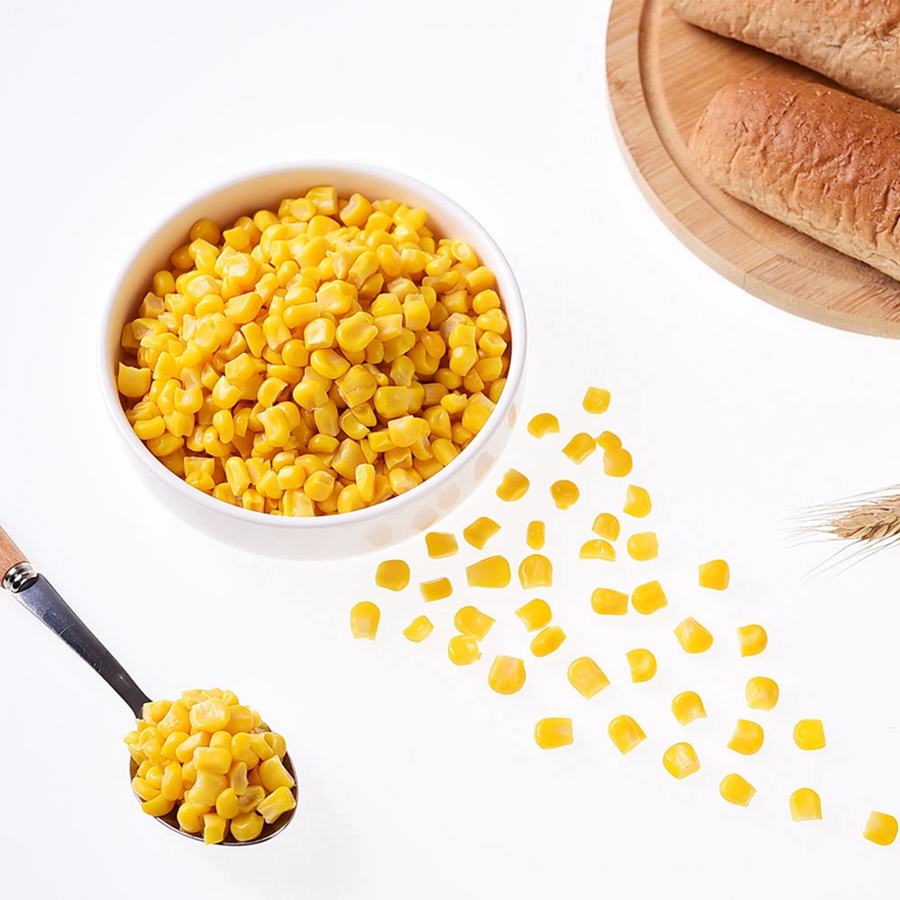
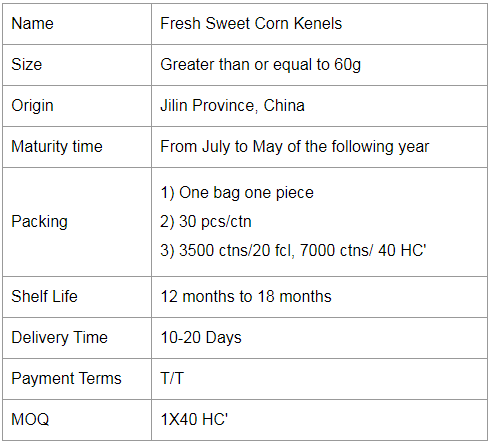
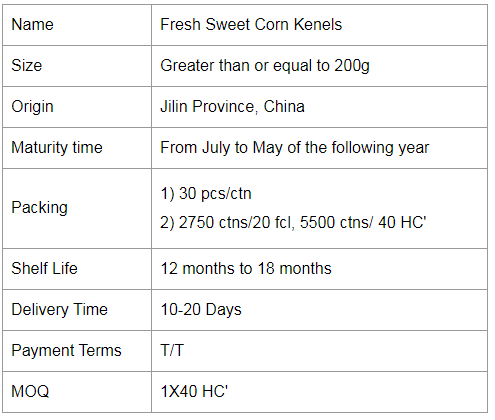
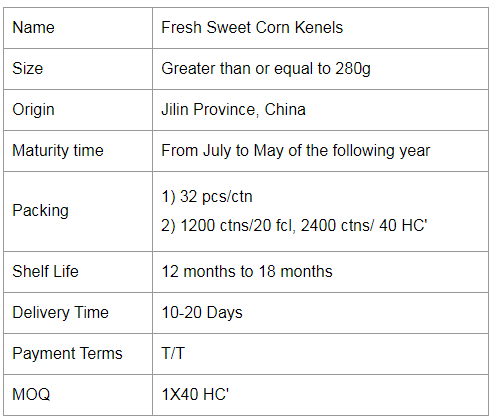
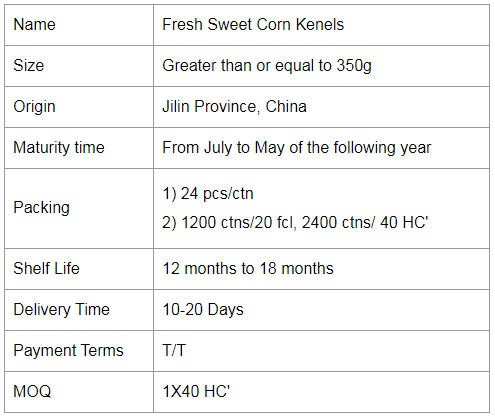
If you would like to work together, please send us a message on our website or contact us by email.
Sweet Corn Pellet,Sweet Corn Kernel,Corn Kernel,Roasted Corn Kernels
Jilin Province Argricultural Sister in Law Food Co., Ltd. , https://www.nscorn.com